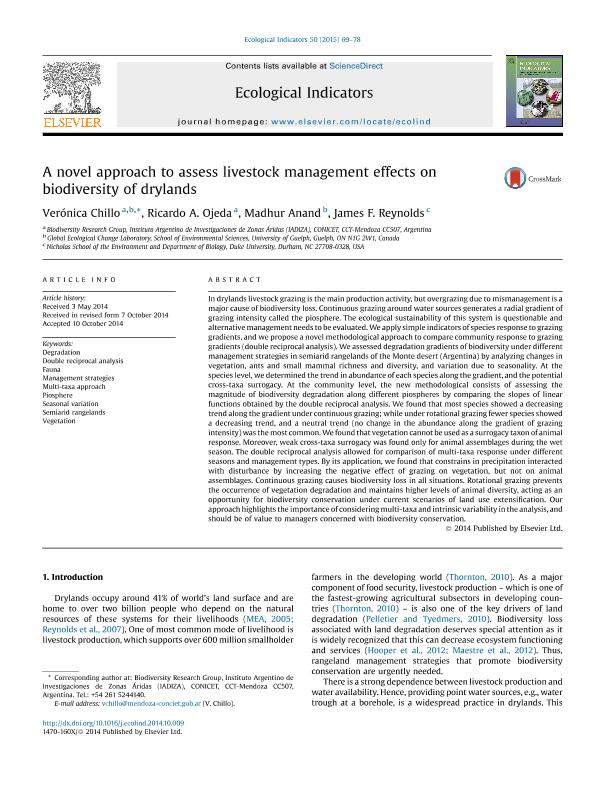Mostrar el registro sencillo del ítem
dc.contributor.author
Chillo, María Verónica

dc.contributor.author
Ojeda, Ricardo Alberto

dc.contributor.author
Anand, Madhur
dc.contributor.author
Reynolds, James F.
dc.date.available
2018-02-28T18:56:43Z
dc.date.issued
2015-03
dc.identifier.citation
Chillo, María Verónica; Ojeda, Ricardo Alberto; Anand, Madhur; Reynolds, James F.; A novel approach to assess livestock management effects on biodiversity of drylands; Elsevier Science; Ecological Indicators; 50; 3-2015; 69-78
dc.identifier.issn
1470-160X
dc.identifier.uri
http://hdl.handle.net/11336/37451
dc.description.abstract
In drylands livestock grazing is the main production activity, but overgrazing due to mismanagement is a major cause of biodiversity loss. Continuous grazing around water sources generates a radial gradient of grazing intensity called the piosphere. The ecological sustainability of this system is questionable and alternative management needs to be evaluated. We apply simple indicators of species response to grazing gradients, and we propose a novel methodological approach to compare community response to grazing gradients (double reciprocal analysis). We assessed degradation gradients of biodiversity under different management strategies in semiarid rangelands of the Monte desert (Argentina) by analyzing changes in vegetation, ants and small mammal richness and diversity, and variation due to seasonality. At the species level, we determined the trend in abundance of each species along the gradient, and the potential cross-taxa surrogacy. At the community level, the new methodological consists of assessing the magnitude of biodiversity degradation along different piospheres by comparing the slopes of linear functions obtained by the double reciprocal analysis. We found that most species showed a decreasing trend along the gradient under continuous grazing; while under rotational grazing fewer species showed a decreasing trend, and a neutral trend (no change in the abundance along the gradient of grazing intensity) was the most common. We found that vegetation cannot be used as a surrogacy taxon of animal response. Moreover, weak cross-taxa surrogacy was found only for animal assemblages during the wet season. The double reciprocal analysis allowed for comparison of multi-taxa response under different seasons and management types. By its application, we found that constrains in precipitation interacted with disturbance by increasing the negative effect of grazing on vegetation, but not on animal assemblages. Continuous grazing causes biodiversity loss in all situations. Rotational grazing prevents the occurrence of vegetation degradation and maintains higher levels of animal diversity, acting as an opportunity for biodiversity conservation under current scenarios of land use extensification. Our approach highlights the importance of considering multi-taxa and intrinsic variability in the analysis, and should be of value to managers concerned with biodiversity conservation.
dc.format
application/pdf
dc.language.iso
eng
dc.publisher
Elsevier Science

dc.rights
info:eu-repo/semantics/openAccess
dc.rights.uri
https://creativecommons.org/licenses/by-nc-nd/2.5/ar/
dc.subject
Degradation
dc.subject
Double Reciprocal Analysis
dc.subject
Fauna
dc.subject
Management Strategies
dc.subject
Multi-Taxa Approach
dc.subject
Piosphere
dc.subject
Seasonal Variation
dc.subject
Semiarid Rangelands
dc.subject
Vegetation
dc.subject.classification
Otras Ciencias Biológicas

dc.subject.classification
Ciencias Biológicas

dc.subject.classification
CIENCIAS NATURALES Y EXACTAS

dc.title
A novel approach to assess livestock management effects on biodiversity of drylands
dc.type
info:eu-repo/semantics/article
dc.type
info:ar-repo/semantics/artículo
dc.type
info:eu-repo/semantics/publishedVersion
dc.date.updated
2018-02-28T14:14:53Z
dc.journal.volume
50
dc.journal.pagination
69-78
dc.journal.pais
Países Bajos

dc.journal.ciudad
Amsterdam
dc.description.fil
Fil: Chillo, María Verónica. University of Guelph; Canadá. Consejo Nacional de Investigaciones Científicas y Técnicas. Centro Científico Tecnológico Conicet - Mendoza. Instituto Argentino de Investigaciones de las Zonas Áridas. Provincia de Mendoza. Instituto Argentino de Investigaciones de las Zonas Áridas. Universidad Nacional de Cuyo. Instituto Argentino de Investigaciones de las Zonas Áridas; Argentina
dc.description.fil
Fil: Ojeda, Ricardo Alberto. Consejo Nacional de Investigaciones Científicas y Técnicas. Centro Científico Tecnológico Conicet - Mendoza. Instituto Argentino de Investigaciones de las Zonas Áridas. Provincia de Mendoza. Instituto Argentino de Investigaciones de las Zonas Áridas. Universidad Nacional de Cuyo. Instituto Argentino de Investigaciones de las Zonas Áridas; Argentina
dc.description.fil
Fil: Anand, Madhur. University of Guelph; Canadá
dc.description.fil
Fil: Reynolds, James F.. University of Duke; Estados Unidos
dc.journal.title
Ecological Indicators

dc.relation.alternativeid
info:eu-repo/semantics/altIdentifier/url/https://www.sciencedirect.com/science/article/pii/S1470160X1400497X
dc.relation.alternativeid
info:eu-repo/semantics/altIdentifier/doi/http://dx.doi.org/10.1016/j.ecolind.2014.10.009
Archivos asociados
